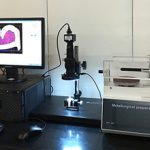Email:
zhaizhongbing723@gmail.com
With the rapid development of technology, the level of industrial production automation is continuously improving, leading to an increased demand for test upper computer software. LabVIEW, as a powerful graphical programming language, is widely used in the field of automated testing. This article will discuss the development of automated test upper computer software based on LabVIEW, analyze its advantages and shortcomings, and propose corresponding solutions.
Automated test upper computer software developed based on LabVIEW has many advantages, but it also has certain shortcomings in practical applications. Through continuous improvement and optimization, we can fully leverage the strengths of LabVIEW and contribute to the field of automated testing in our country. In the future, with the continuous development of graphical programming technologies such as LabVIEW, automated test upper computer software will become more sophisticated, bringing more convenience and value to various industries.

Microscope Chromosome Karyotype Analysis Upper Computer Software Development
With the continuous development of biotechnological sci […]

Development of host computer program for electric servo test
The application of electric actuators in various fields […]

Development of an Intelligent Picking System for Robotic Arms Based on Machine Vision
Intelligent manufacturing is gradually becoming an impo […]

Custom Development of an Online Monitoring System for Production Equipment
The manufacturing sector plays an increasingly vital ro […]

Development of a Frequency Converter Upper Computer System
Frequency converters, as pivotal equipment for regulati […]

Custom Development of Ultrasonic Radar Testing Upper Computer
The demand for ultrasonic radars in fields such as auto […]

Software Development for Water Quality Algae Monitoring and Identification System.
Project BackgroundFaced with the professional detection […]

Smart Home Living Kitchen System: Dual-End Cooking Robot APP Development
Project Background To enhance the core competitiveness […]

Smart Weeding Machine Android and iOS Mobile Dual-Platform Control APP Program Development and Customization
Case Background With the advancement of technology and […]

Development of an Automated Control Host Computer System for Laboratory Microscopes
Project Background A certain biotechnology company spec […]

The development of an intelligent self-service charging station control system for new energy electric vehicles
Project Background With the development of smart grids, […]

Cross-border e-commerce shop agent declaration platform system: Oudai independent declaration software customization development
Case Background According to the new regulations on com […]


WhatsApp:
Email:zhaizhongbing723@gmail.com
Address:Zone E, 10th Floor, HongKong Shenzhen International Center, Longhua District, Shenzhen